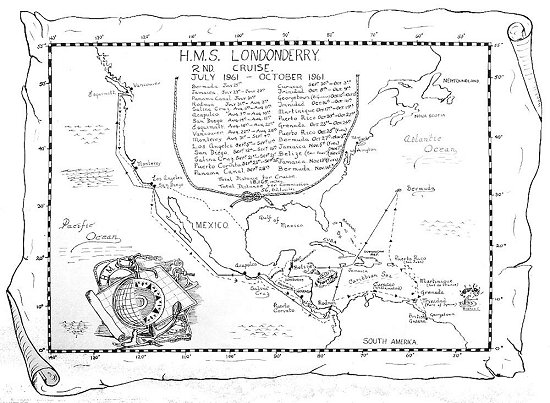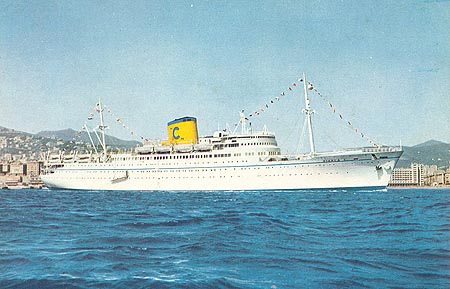
Click on chart for larger version

| Place | Arrived | Departed |
| Bermuda | 25th Jul 1961 | |
| Jamaica | 29th Jul 1961 | 29th Jul 1961 |
| Panama Canal | 31st Jul 1961 | 31st Jul 1961 |
| Rodman USN Base | 31st Jul 1961 | 3rd Aug 1961 |
| Salina Cruz | 6th Aug 1961 | 6th Aug 1961 |
| Acapulco | 7th Aug 1961 | 10th Aug 1961 |
| San Diego | 14th Aug 1961 | 15th Aug 1961 |
| Esquimalt | 18th Aug 1961 | 22nd Aug 1961 |
| Vancouver | 22nd Aug 1961 | 26th Aug 1961 |
| Monterey | 31st Aug 1961 | 4th Sep 1961 |
| Los Angeles | 5th Sep 1961 | 11th Sep 1961 |
| San Diego | 12th Sep 1961 | 16th Sep 1961 |
| Salina Cruz | 21st Sep 1961 | 21st Sep 1961 |
| Puerto Corinto | 23rd Sep 1961 | 25th Sep 1961 |
| Panama Canal | 28th Sep 1961 | 28th Sep 1961 |
| Curacao | 30th Sep 1961 | 3rd Oct 1961 |
| Trinidad | 5th Oct 1961 | 9th Oct 1961 |
| George Town | 10th Oct 1961 | 15th Oct 1961 |
| Trinidad | 16th Oct 1961 | 16th Oct 1961 |
| Martinique | 17th Oct 1961 | 19th Oct 1961 |
| Puerto Rico | 20th Oct 1961 | 22nd Oct 1961 |
| Grenada | 23rd Oct 1961 | 24th Oct 1961 |
| Puerto Rico | 25th Oct 1961 | 25th Oct 1961 |
| Bermuda | 27th Oct 1961 | 3rd Nov 1961 |
| Jamaica | 5th Nov 1961 | 5th Nov 1961 |
| Belize | 7th Nov 1961 | 11th Nov 1961 |
| Jamaica | 13th Nov 1961 | 13th Nov 1961 |
| Bermuda | 16th Nov 1961 |
On Tuesday, 25th July, we once more put to sea. This was probably the cruise we had been looking forward to most. It was certainly no disappointment. The west coast of America and as far north as Vancouver. After stopping for fuel at Kingston, Jamaica, we pressed on south to the Panama Canal making an uneventful passage through the great locks. The canal is a terrifically impressive feat of engineering and is operated so smoothly and efficiently that it is difficult to realise that one has moved in a few short hours from the Caribbean to the Pacific. We now know why most of the American bases are on the west coast - it's calmer. The buffer stated that he had seen an alligator in the Canal - but this was unconfirmed...
Another short stop for fuel at Salina Cruz in Mexico and then on to Acapulco. Here is a seaside resort with just about everything from the filthy rich to the just plain rich, and the just plain filthy.
Anchored out in the beautiful bay for three days we were almost continually surrounded by water-skiers showing off and sometimes falling off. Here too we were introduced to tequila, Mexico's own brand of atomic warfare, at a party given by Pepsi-Cola for half the ship's company. By the time the party was over we had enlisted the entire Mexican band on twelve-year engagements and had attempted to add the ten foot centre piece - an imitation bottle of Pepsi as a second funnel.*My recollection is of a circular item in Pepsi colours lodged temporarily (until spotted by the wardroom) between the GDP directors?The throb of the engines being matched by the throbbing in our heads we sailed on to San Diego, the main west coast base of the USN, stopped there for a day and then pressed on to Esquimalt. Esquimalt is the home of the Canadian Pacific Fleet at the southern tip of Vancouver Island, in British Columbia. It is bordered to the east by the provincial capital Victoria, which is supposed to be the nearest thing to England that Canada has. The hospitality showered on us there was utterly fantastic. The visit was sadly marred by the death in a motor vehicle accident of M(E)1 Roy, who was buried with full naval honours in the quiet, beautiful naval cemetery. No one could have been more sympathetic than the Canadians, and the Royal Canadian Navy could not have been more helpful. A headstone has been erected by them.
We sailed under Lions Gate Bridge into Vancouver on the 23rd August for the Pacific National Exhibition. Although a wonderfully hospitable place, Vancouver is a huge city and during such a festive season one small British frigate was somewhat lost. An awful lot of us were found taking the ferry back to Esquimalt.Sailing again, this time to Monterey in California. It was here that HMS Puma had been presented with a live puma and we were there to return the County's kindness on behalf of Puma. Monterey County put on a great show of hospitality and kindness, even going to the extent of arranging a rodeo for us. Many of us were invited into American homes and on sailing there was a feeling that relations between Monterey County and the Royal Navy had been fostered into ones of deep friendship and mutual respect.
From Monterey to Long Beach, arriving on 12th September. Here is the dream land of Hollywood and Disneyland and once again, exceptional hospitality. Then back to San Diego, once more becoming tourists proper, enjoying all the sights, and there were plenty of them, making more friends and sampling a goodly amount of the local chemical and root beers, bourbon and rye. We left San Diego on 16th September, stopping once more at Salina Cruz for fuel before proceeding to Puerto Corinto in Nicaragua. This was very much an underdeveloped port, with the town's main street being rough dirt. We played a couple of games of football and one or two attempted the rather hazardous journey to Managua, the capital, having quite a good time there. A quiet run ashore for those who made it after the excesses of the US and Canadian West Coast.
We went back through the Panama canal, stopping off for a short time at the Rodman USN base visiting their excellent PX store for rabbits and arriving at Willemstadt, Curacao, on the 30th September. Willemstadt was a pretty and quiet run ashore and some of us will better remember Campo Allegro, an establishment out of town, rather like a Butlin's Holiday Camp. Here we took part in a "war" exercise our landing parties lead by Lieutenant Layman beating the Dutch Marines (I don't think so) and shooting a couple of our own men into the bargain (?). On the move again we once more visited Port of Spain, Trinidad, getting in some sport and renewing our aquaintance with the "Gaza Strip". Then away again anchoring off George Town, British Guiana, enjoying more sporting fixtures, visits to estates and a couple of very good dances. Next Fort de France, Martinique, for a couple of days with the French army assisting in arranging bus trips around the island. Martinique is one of the most beautiful islands in the West Indies. On leaving Fort de France we gave HMS Diamond Rock a seven gun salute.
Bianca 'C'
Friday, 20th October saw us in Puerto Rico with all the conveniences of the USN base, but our stay was short lived after we received a request during the evening of Sunday 22nd October to proceed immediately to the Italian liner Bianca C which had been abandoned on fire, anchored in the deep water entrance channel to St. Georges, Grenada.
At midnight Londonderry departed San Juan arriving off St. Georges at 1815 on Monday 23rd October. It had been confirmed that all the passengers and surviving crew were safe ashore, (one crewman died immediately onboard in the explosion and subsequent fire, two others died later from their injuries) After negotiations with the master of the Bianca C it was agreed that we attempt to tow the stricken, still smouldering vessel, out of the fairway. Her anchor cables had first to be blown off before she could be towed stern first out of the channel. The tow parted and was reconnected several times during the night and following day. Unfortunately at 1123 on Tuesday 24th October, in a cloud of steam she sank to the bottom of the Caribbean, but clear of St. Georges harbour entrance.Copies of the HMS Londonderry deck log for the 23rd and 24th October 1961 can be viewed by clicking on this link. These copies are by permission of the UK National Archives and are not for commercial use without their permission.
We then returned to San Juan to pick up the lads that had been left behind after our hasty departure who, incidently, had been given 50 dollars between them by a naval padre, and had spent the rest of their stay looking for more padres. We arrived back in Bermuda on the 27th October after an extremely lively and successful cruise.
Bianca C in happier times
Hurricane Hattie
There is no peace for the wicked, however, and so it was on the 3rd November that we sailed for British Honduras to assist the victims of Hurricane Hattie. We stopped off at Kingston, Jamaica, to load 85 tons of hurricane relief stores, a job we completed in 3¼ hours. We also collected ten doctors and a Methodist chaplain. At 0700 we arrived at Belize in British Honduras and unloaded about half of our stores there. Seven of the ten doctors and the chaplain also went ashore. For four days we patrolled the coastline, sending food and medical stores ashore at many of the small villages and settlements and rendering medical aid where required. Many people had been killed and thousands had been rendered homeless by the disaster. In some of the bigger towns, like Belize, there was a terrible apathy among the natives who were quite prepared to let somebody come and do the work, not being prepared to help themselves at all. A system of "no work-no food" had to be instituted in some places but in others where effective and energetic leadership boosted local morale tremendously, the situation was well in hand. A lot of technical work was put in by our own technicians at Stann Creek. HMS Troubridge did sterling work in Belize itself, and the Americans provided a tremendous amount of assistance.
On the 12th November, after having organised transport, lighting, ferry services, food and medical supplies, we sailed back to Bermuda, dropping doctors and refuelling at Jamaica en route. The job had been a real tonic to us, giving us the feeling that we had been able to help somebody and that we had done it well.